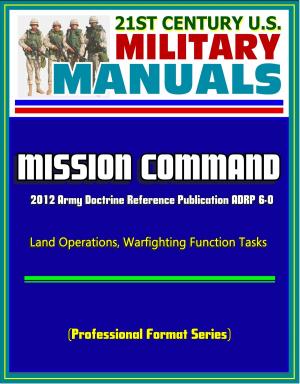Developing and Applying Synthesis Models of Emerging Space Systems: Military Small Satellites, DoD MILSATCOM, ISR, Commercial Small Satellites, Research, Cost Estimation and Acquisition, Launchers
Nonfiction, Science & Nature, Technology, Aeronautics & Astronautics, History, Military, Aviation| Author: | Progressive Management | ISBN: | 9781370070947 |
| Publisher: | Progressive Management | Publication: | October 25, 2016 |
| Imprint: | Smashwords Edition | Language: | English |
| Author: | Progressive Management |
| ISBN: | 9781370070947 |
| Publisher: | Progressive Management |
| Publication: | October 25, 2016 |
| Imprint: | Smashwords Edition |
| Language: | English |
This excellent report has been professionally converted for accurate flowing-text e-book format reproduction. The Department of Defense's (DOD) large satellites provide robust capabilities, but they are ill designed to combat emerging threats and concerns like anti-satellite weapons and a shrinking defense budget. Small satellites are a potential solution to this challenge, but the technology is too nascent for the DOD to deploy. This study addressed the DOD's need for further research on small satellites by providing a set of decision support tools that enables the exploration of small satellite physical trade-offs early in the conceptual design phase of the DOD space acquisition process. Early phases of the systems engineering process were used to identify DOD small satellite requirements and key input factors and output responses that drove meta-model development through the use of model-based systems engineering. Microsoft Excel and JMP software were employed to build synthesis models used in the decision support tools developed. The decision support tools analyzed the relationship between small satellite design inputs and outputs to provide trade space insights that can assist DOD space acquisition professionals in making better decisions in the conceptual design phase. More informed decision-making in the space acquisition process might preserve valuable DOD resources that may have otherwise been wasted.
CHAPTER I - INTRODUCTION * A. PROBLEM STATEMENT * B. SATELLITE USE IN THE U.S. MILITARY * C. THREATS TO DOD SATELLITE CAPABILITIES * D. RESEARCH QUESTIONS * E. CONTRIBUTION * F. METHODOLOGY * G. SCOPE * H. THESIS ORGANIZATION * CHAPTER II - LITERATURE REVIEW * A. SATELLITES IN THE DOD * 1. Military SATCOM * a. Narrowband * b. Wideband * c. Protected. * 2. ISR Satellites * 3. PNT Satellites * 4. Disadvantages of Current DOD Satellites * B. EMERGING DOD SPACE SOLUTIONS * 1. Small Satellites * a. Commercial Use of Small Satellites * b. DOD Use of Small Satellites * 2. High Altitude Air Ships * C. THE CURRENT STATE OF DOD SMALL SATELLITE RESEARCH * 1. Analysis of Small Satellite Design * a. Determining Small Satellite Design * b. Constellation Design for a Single Small Satellite Program * 2. Small Satellite Cost Estimation and Acquisition * D. MODELING TO ILLUSTRATE TRADE SPACE * E. CONCLUSION * CHAPTER III - APPLYING THE SYSTEMS ENGINEERING METHODOLOGY * A. PROBLEM REFINEMENT * 1. Scope * 2. Assumptions * B. OVERVIEW OF THE SE PROCESS * C. PROBLEM DEFINITION * 1. Operational Concept * 2. Context Diagram * 3. Definition of the Problem * D. STAKEHOLDER ANALYSIS * 1. Definition of Need * 2. Limitations and Constraints * 3. Boundary Conditions * a. Physical Boundary * b. Functional Boundary * E. REQUIREMENTS ANALYSIS * F. FUNCTIONAL ANALYSIS AND ALLOCATION * G. KEY FACTORS ANALYSIS * CHAPTER IV - BUILDING THE SYNTHESIS MODEL * A. MODEL-BASED SYSTEMS ENGINEERING * B. DEVELOPING THE MS EXCEL TOOL FOR INPUT RESPONSES * 1. Synthesis Model: ISR Payload Worksheet * 2. Synthesis Model: MILSATCOM Payload Worksheet * 3. Synthesis Model: Satellite Bus Worksheets * a. Mass and Size Worksheet * b. Orbital Period/Revisit Time Worksheet * c. Cost Worksheet * C. DOE * D. DEVELOPING THE JMP TOOL * E. FINALIZING THE DECISION SUPPORT TOOLS * F. CONCLUSION * CHAPTER V - SCENARIO ANALYSIS * A. TEST SCENARIO * B. USING THE TOOLS * C. CONCLUSION * CHAPTER VI - FUTURE WORK AND CONCLUSIONS * A. RECOMMENDATIONS FOR FOLLOW-ON WORK * 1. Increase the Number of Key Factors Analyzed * 2. Refining the Data Used in Models * 3. More Data on Launch Vehicles * 4. Other Emerging Space Capabilities * 5. Refining the DOE * 6. Improve Usability and Functionality of the Tools * B. CONCLUSION
This excellent report has been professionally converted for accurate flowing-text e-book format reproduction. The Department of Defense's (DOD) large satellites provide robust capabilities, but they are ill designed to combat emerging threats and concerns like anti-satellite weapons and a shrinking defense budget. Small satellites are a potential solution to this challenge, but the technology is too nascent for the DOD to deploy. This study addressed the DOD's need for further research on small satellites by providing a set of decision support tools that enables the exploration of small satellite physical trade-offs early in the conceptual design phase of the DOD space acquisition process. Early phases of the systems engineering process were used to identify DOD small satellite requirements and key input factors and output responses that drove meta-model development through the use of model-based systems engineering. Microsoft Excel and JMP software were employed to build synthesis models used in the decision support tools developed. The decision support tools analyzed the relationship between small satellite design inputs and outputs to provide trade space insights that can assist DOD space acquisition professionals in making better decisions in the conceptual design phase. More informed decision-making in the space acquisition process might preserve valuable DOD resources that may have otherwise been wasted.
CHAPTER I - INTRODUCTION * A. PROBLEM STATEMENT * B. SATELLITE USE IN THE U.S. MILITARY * C. THREATS TO DOD SATELLITE CAPABILITIES * D. RESEARCH QUESTIONS * E. CONTRIBUTION * F. METHODOLOGY * G. SCOPE * H. THESIS ORGANIZATION * CHAPTER II - LITERATURE REVIEW * A. SATELLITES IN THE DOD * 1. Military SATCOM * a. Narrowband * b. Wideband * c. Protected. * 2. ISR Satellites * 3. PNT Satellites * 4. Disadvantages of Current DOD Satellites * B. EMERGING DOD SPACE SOLUTIONS * 1. Small Satellites * a. Commercial Use of Small Satellites * b. DOD Use of Small Satellites * 2. High Altitude Air Ships * C. THE CURRENT STATE OF DOD SMALL SATELLITE RESEARCH * 1. Analysis of Small Satellite Design * a. Determining Small Satellite Design * b. Constellation Design for a Single Small Satellite Program * 2. Small Satellite Cost Estimation and Acquisition * D. MODELING TO ILLUSTRATE TRADE SPACE * E. CONCLUSION * CHAPTER III - APPLYING THE SYSTEMS ENGINEERING METHODOLOGY * A. PROBLEM REFINEMENT * 1. Scope * 2. Assumptions * B. OVERVIEW OF THE SE PROCESS * C. PROBLEM DEFINITION * 1. Operational Concept * 2. Context Diagram * 3. Definition of the Problem * D. STAKEHOLDER ANALYSIS * 1. Definition of Need * 2. Limitations and Constraints * 3. Boundary Conditions * a. Physical Boundary * b. Functional Boundary * E. REQUIREMENTS ANALYSIS * F. FUNCTIONAL ANALYSIS AND ALLOCATION * G. KEY FACTORS ANALYSIS * CHAPTER IV - BUILDING THE SYNTHESIS MODEL * A. MODEL-BASED SYSTEMS ENGINEERING * B. DEVELOPING THE MS EXCEL TOOL FOR INPUT RESPONSES * 1. Synthesis Model: ISR Payload Worksheet * 2. Synthesis Model: MILSATCOM Payload Worksheet * 3. Synthesis Model: Satellite Bus Worksheets * a. Mass and Size Worksheet * b. Orbital Period/Revisit Time Worksheet * c. Cost Worksheet * C. DOE * D. DEVELOPING THE JMP TOOL * E. FINALIZING THE DECISION SUPPORT TOOLS * F. CONCLUSION * CHAPTER V - SCENARIO ANALYSIS * A. TEST SCENARIO * B. USING THE TOOLS * C. CONCLUSION * CHAPTER VI - FUTURE WORK AND CONCLUSIONS * A. RECOMMENDATIONS FOR FOLLOW-ON WORK * 1. Increase the Number of Key Factors Analyzed * 2. Refining the Data Used in Models * 3. More Data on Launch Vehicles * 4. Other Emerging Space Capabilities * 5. Refining the DOE * 6. Improve Usability and Functionality of the Tools * B. CONCLUSION















